17 - Major Salivary Glands
Editors: Mills, Stacey E.
Title: Histology for Pathologists, 3rd Edition
Copyright 2007 Lippincott Williams & Wilkins
> Table of Contents > VII - Alimentary Tract > 22 - Esophagus
function show_scrollbar() {}
22
Esophagus
Franco G. DeNardi
Robert H. Riddell
Embryology
In the early stages of development, the notochord induces the formation of the foregut from endoderm (1). At about 21 days' gestation, septa arise from the lateral walls of the foregut, fuse, and divide the foregut into the esophagus and trachea. This process of septation begins at the carina and extends cephalad, being completed by five to six weeks' gestation (Figure 22.1).
The esophagus is initially lined by a thin layer of stratified columnar epithelium, which proliferates to almost occlude the lumen (2). At six to seven weeks, the lumen is reformed as a result of epithelial vacuolization (2) (Figure 22.2). As early as eight weeks' gestation and beginning in the middle one-third of the esophagus, ciliated cells appear and extend cephalad and caudally to almost cover the entire stratified columnar epithelium (2,3,4). At approximately 10 weeks a single layer of columnar cells populates the proximal and distal ends of the esophagus (2). At approximately four months' gestation, the esophageal cardiac-type glands form as a result of the downward growth of these columnar cells into the lamina propria, with subsequent proliferation and differentiation (3,5). They go distally as far as the oxyntic mucosa, so that similar glands can be found in the cardia. Some have used this to argue that the cardia is therefore intrinsically part of the esophagus (6), although it could just as easily be interpreted that they are just present in all mucosae proximl to oxyntic mucosa.
At approximately five months' gestation, stratified squamous epithelium initially appears in the middle one-third of the esophagus and extends cephalad and caudally, replacing the ciliated epithelium (3,4). The upper esophagus is the last area to be replaced by squamous epithelium; and, if this process of squamous replacement is not completed at birth, there may be persistence of ciliated cells in the upper esophagus (2,4) (Figure 22.3). These residual cells are usually short lived, being replaced by squamous epithelium within two to three days postpartum (4,7). However, in some patients they either persist into adult life or there is metaplasia back to ciliated cells (8). The single layer of
P.566
columnar cells is also replaced by squamous epithelium, although some cells may persist at birth, usually located over the esophageal cardiac glands. The submucosal glands develop after the appearance of the squamous epithelium and are likely derived from this squamous epithelial layer (4,7).
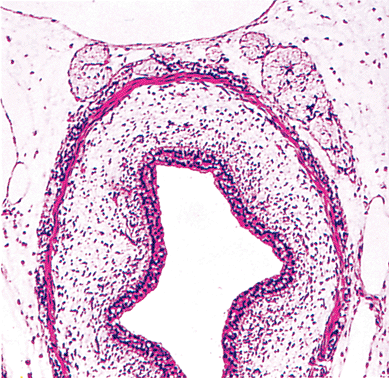 |
Figure 22.1 Fetal esophagus (late first trimester). Transverse section overview of the esophagus demonstrating inner mucosal layer, middle submucosal layer, and thin outer muscle layer. Note the vagus nerves lying over the esophagus. |
Development of the gastrointestinal neuromuscular system begins at four weeks with neural crest cells entering the foregut and migrating rostrocaudally. The myenteric plexus develops first, followed by formation of the submucosal plexus two to three weeks later. At about six weeks' gestation, the circular muscle layer develops, followed by the development of the longitudinal layer at approximately nine weeks' gestation. Initially, the muscularis propria consists entirely of smooth muscle, after which striated muscle gradually develops in the upper esophagus so that by five months the normal ratio and arrangement of both muscle types are established (4). Interstitial cells of Cajal appear at week nine and become closely associated with the myenteric plexus (9). By week 14 the fetal gut has a mature appearance (9).
 |
Figure 22.2 Fetal esophagus (late first trimester). The epithelial layer is composed of stratified columnar epithelium. Note the lack of muscularis mucosae. |
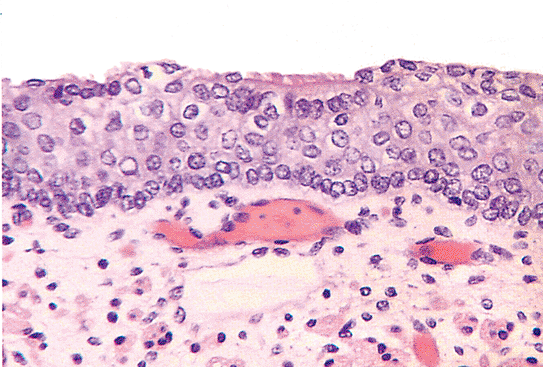 |
Figure 22.3 Fetal esophagus (third trimester). The epithelial layer at this stage consists of stratified squamous epithelium with occasional ciliated cells on the surface. Note the individual smooth muscle cells of developing muscularis mucosae. |
Developmental defects of the esophagus can be attributed to errors in this morphogenetic sequence. The notochord can induce the formation of the neural tube, gastrointestinal tract, and other organ systems. It has been shown experimentally that a split notochord can result in the duplication of any region of the gastrointestinal tract (1), which may include duplications of the esophagus ranging from the more common cysts to esophagus segments of variable length (1,10,11). As a consequence of this ability to induce development of more than one organ system, any patient presenting with duplications, segmental or cystic, should undergo radiologic evaluation that specifically explores for axial skeletal defects. Occurence of abnormalities during the phase of foregut septation is one proposed mechanism for the formation of tracheoesophageal fistulas (with or without atresia) or of mediastinal cysts of bronchogenic or esophageal origin (12,13). It has been suggested that esophageal duplications also may occur as a result of segments of fused vacuoles formed during the vacuolization phase persisting and differentiating toward esophageal structures (1).
Topography and Relations
The esophagus begins in the neck at the cricoid cartilage, passes through the thorax within the posterior mediastinum, and extends for several centimeters past the diaphragm to its junction with the stomach. The overall length varies with trunk length, but in the adult the average length is approximately 23 to 25 cm. In practice, endoscopic distances are measured from the incisor teeth; and, in the average male, the junction of the esophagus and stomach is generally considered to be approximately 40 cm from the incisors. This length may vary from approximately 38 to 43 cm. Although convenient and commonly used in practice, the use of this distance is a crude and unreliable measurement for locating the gastroesophageal junction. It
P.567
has been found that the esophageal length correlates with height in children (14).
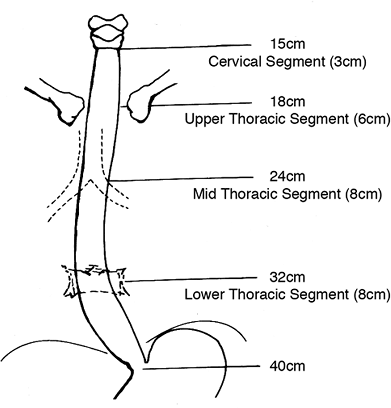 |
Figure 22.4 Esophageal segments with approximate lengths and distances from the incisors. |
For the purpose of classification, staging, and reporting of esophageal malignancy, the International Union Against Cancer suggests division into four segments, with distances measured from the incisors (15) (Figure 22.4). The cervical esophagus extends from the cricoid cartilage (roughly 15 cm) to the level of the thoracic inlet (approximately 18 cm). The upper thoracic segment extends from the thoracic inlet to the tracheal bifurcation (around 24 cm). The midthoracic segment extends to the level of the eighth thoracic vertebra (approximately 32 cm), and the lower thoracic segment extends to the junction with the stomach (40 cm).
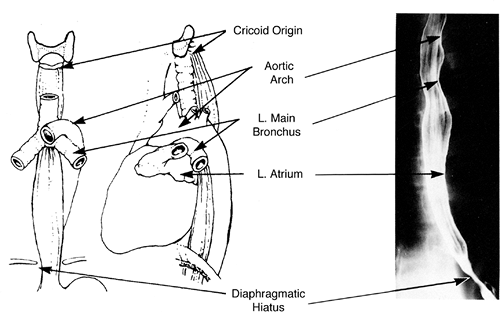 |
Figure 22.5 Relationship of the esophagus with normal esophageal constrictions. Barium swallow of the normal esophagus (right) demonstrates narrowing of the lumen at the sites of constriction. |
Along its course, the normal esophagus has several points of constriction (Figure 22.5). These occur at the cricoid origin of the esophagus, along the left side of the esophagus at the aortic arch, at the crossing of the left main bronchus and left atrium, and where the esophagus passes through the diaphragm. These constrictions may become clinically significant if food or pills become lodged at these sites of luminal narrowing, with the possibility of contact mucosal injury. The most common sites for lodgement are at the level of the aortic arch and left atrium, where, especially in patients with left atrial enlargement, compression may become significant (16,17,18).
Knowledge of the relationships of the esophagus with other anatomic structures is important because these relationships may be directly affected by esophageal diseases such as carcinoma or diverticula. Disease of adjacent structures may cause local compression of the esophagus, resulting in dysphagia or lodgement of food or pills. The cervical esophagus is posterior to the trachea and bounded on both sides by the recurrent laryngeal nerve and the carotid sheath and its structures. The thyroid gland overlaps the esophagus in its cervical segment. In the thoracic segment,
P.568
the esophagus continues posterior to the trachea to the level of bifurcation, a site for the formation of the rare midesophageal diverticula secondary to traction from inflamed mediastinal lymph nodes (19). The esophagus courses posterior to the left atrium. The azygous veins ascend on either side of the thoracic segment.
Initially, the right and left vagus nerves run lateral to the esophagus, giving branches that form plexi on the posterior and anterior esophageal surfaces. At variable sites in the lower thoracic segment, the left and right nerves course onto the anterior and posterior surfaces of the esophagus, respectively, divide to form the anterior and posterior plexuses, and then reunite to form the anterior and posterior vagal trunks that course down to the stomach. An awareness that variations of this pattern exist is most important for the surgeon performing vagotomies. In the abdomen, the liver forms an impression on the anterior aspect of the esophagus. On the right side the junction with the stomach is smooth, whereas on the left the junction forms a sharp angle known as the incisura or angle of His.
The esophagus enters the abdomen by passing through the esophageal hiatus, which is formed by muscles of the diaphragm and contains the phrenoesophageal ligament. In most cases, the muscle sling encircling the esophagus is formed entirely from the right diaphragmatic crus (20), although variations of this pattern do occur. The phrenoesophageal ligament arises from the fascia of the abdominal diaphragm and divides into an ascending and descending leaf. The former passes up through the hiatus to insert approximately 2 to 3 cm above the hiatus, whereas the descending leaf has a variable insertion at or below the gastroesophageal junction or even into the gastric fundus (21). Proposed functions of the phrenoesophageal ligament include (a) assisting in maintaining the pressure differential between the thorax and abdomen, (b) providing fixation mechanisms with maintenance of the gastroesophageal junction within the abdomen during episodes of increased intra-abdominal pressure, and (c) contributing to the competence of the lower esophageal sphincter (LES), thus representing a possible mechanism for the absence of reflux in some patients with hiatal hernias (21,22,23).
Macroscopic/Endoscopic Features
In the empty state, the esophagus has an irregular outline as a result of the mucosa and submucosa being thrown into longitudinal folds. During endoscopy, insufflation causes distension so that these folds may not be appreciated, and the mucosa is seen to be a uniform white-pink.
Glycogenic Acanthosis
Glycogenic acanthosis can be seen in up to 25% of the population with the combined use of endoscopy and barium studies (24,25,26). Macroscopically, glycogenic acanthosis interrupts the uniformity of the mucosa and presents as white nodules or small plaques on the mucosal folds, primarily in the distal one-third of the esophagus. These lesions vary in size, may be up to 1 cm in diameter, and, if extensive, may coalesce to larger plaques. Microscopically, glycogenic acanthosis consists of hyperplasia of the cells of the prickle layer containing abundant glycogen. Glycogenic acanthosis may resemble, and thus may be confused macroscopically with, monilial plaques or leukoplakia. Glycogenic acanthosis should be considered a variant of normal with as yet no defined relationship to infection or malignancy.
Heterotopias
Heterotopias are defined as normal tissue occurring in sites not expected for that tissue. In the literature, structures accepted as esophageal heterotopias are inconsistently defined. Esophageal cardiac-type glands and ciliated epithelium have been considered as heterotopias (7,8,27,28) or as embryologic remnants (4) by some investigators. The categorization of melanocytes and argyrophilic cells, including Merkel cells and endocrine cells, presents a similar problem because these cells have not been regularly found in the esophagus (29,30). Melanosis has also been described (31,32,33).
Gastric body type mucosa has been described occurring in the upper one-third of the esophagus, usually within 3.0 cm of the upper esophageal sphincter (4,7,27), hence the designation inlet patch (Figure 22.6). These heterotopias have been found in approximately 2 to 4% of esophagi and can be found at all ages. Macroscopically, they have a deep pink, velvety appearance, and the junction with squamous epithelium is similar in appearance to the
P.569
mucosal gastroesophageal junction (27). Associated small peptic erosions or ulcers occasionally are identified nearby.
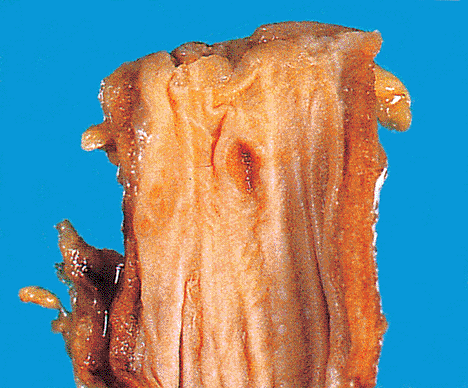 |
Figure 22.6 Proximal esophagus. Gastric body heterotopia situated slightly distal from the esophageal origin. |
 |
Figure 22.7 Proximal esophagus. Gastric body heterotopia composed of cardiac-type mucosa with scattered chief cells and a mild chronic inflammatory cell infiltrate. |
Microscopically, the heterotopic mucosa contains a variable number of parietal and chief cells with a variable chronic inflammatory cell infiltrate usually related to Helicobacter infection (27) (Figure 22.7). Acid production and symptoms have been attributed to heterotopias of larger size. These heterotopias along with the esophageal cardiac-type glands have been implicated as possible origins for the rare occurrence of adenocarcinoma of the upper esophagus (34,35). Theories for the origin of these heterotopias include a metaplastic change in preexisting cardiac-type glands, cell arrest where cells destined to become body mucosa remain in the esophagus rather than descend to the site of the future stomach, or otherwise unexplained heterotopia (4,27).
Sebaceous glands are occasionally found in the esophagus (Figure 22.8) and have been accepted as heterotopias without controversy (36,37). Thyroid tissue also has been described as heterotopic tissue in the esophagus (38). Pancreatic metaplasia is probably the most common form of metaplasia in the cardia, usually close to the Z line, although it also may be found in Barrett's esophagus and in an inlet patch (39,40,41) (Figure 22.9). While it has no known significance, if it secretes activated pancreatic juice, then it may well potentiate Barrett's esophagus, as it is a normal consituent of duodenal juice, the regurgitation of which into the esophagus is involved in its pathogenesis. Indeed, it is also possible that an alkaline pH or bile in the esophagus stimulates its formation. Endocrine tissue can be observed (personal observation) but is vanishingly rare.
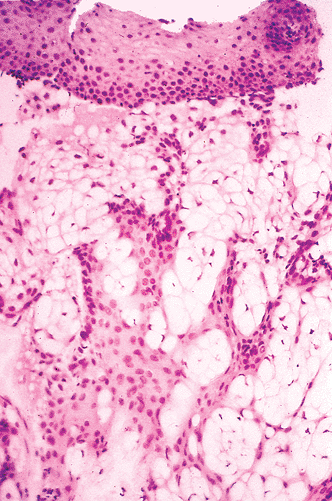 |
Figure 22.8 Sebaceous glands that in this case formed a nodule that was examined via biopsy. |
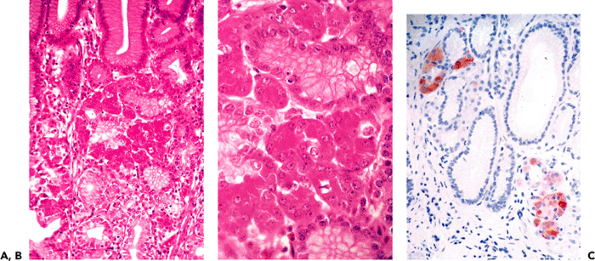 |
Figure 22.9 Pancreatic metaplasia in a biopsy from the cardiac side of the Z line. A. and B. Glands are an admixture of mucus glands and eosinophilic granular cells superficially resembling a cross between gastric chief cells and Paneth's cells. C. Immunocytochemical reactivity is found to pancreatic exocrine hormones, amylase in this case. |
P.570
Esophageal Musculature
The muscular coat of the esophagus consists of an outer longitudinal and inner circular layer. The esophageal entrance is bounded superiorly by the cricopharyngeal and inferior pharyngeal constrictor muscles, both of which contribute muscle fibers to the esophageal musculature (22,23). Horizontal fibers from both these muscles form the upper esophageal sphincter, which manometrically is a localized zone of increased pressure measuring 2 to 4.5 cm in length (20,42,43). Together these muscle groups act in tandem to control the act of swallowing.
The longitudinal layer originates as two bands from its origin at the cricoid cartilage. The muscles sweep dorsally where they incompletely interdigitate, leaving a bare V-shaped area (area of Laimer) exposing the underlying circular layer. This area represents an area of potential weakness where a posterior pulsion diverticulum (Zenker's) may form. Theories regarding Zenker's diverticulum center upon a structural or physiologic abnormality of the cricopharyngeus muscle (44). The circular layer of the esophagus is slightly thinner than the longitudinal layer, a pattern that is reversed from the remainder of the gastrointestinal tract (22,23).
At the gastroesophageal junction, the esophageal longitudinal layer is continuous with the outer longitudinal layer of the stomach. The circular layer continues over the stomach, dividing in the region of the cardia to form the middle circular and inner oblique muscle layers of the stomach. The fibers of the inner oblique layer pass in a slinglike manner at the incisura and cross at right angles with the more horizontally oriented fibers of the middle layer, forming a muscular ring (collare Helvetti) to which a possible sphincter function has been ascribed (22,23).
Lower Esophageal Sphincter
The LES is best defined manometrically, where it presents as a 2- to 4-cm zone of pressure that is higher than intragastric or intraesophageal pressure. The distalmost end of the LES defines the muscular component of the gastroesophageal junction (42). At rest, the sphincter maintains an average pressure of 20 mm Hg (range: 10 26) (20). The function of the LES is to keep the lumen closed during rest, thus preventing reflux, and to relax during swallowing, thereby allowing food to pass through. Physiologically, a competent sphincter exists, and various changes in the musculature of the distal esophagus, thought to represent such a sphincter, have been described (43,45,46,47).
Gastroesophageal Junction
The gastroesophageal junction can be defined physiologically, anatomically, microscopically, or endoscopically and can be considered as being either muscular or mucosal in nature. The muscular gastroesophageal junction is most accurately defined physiologically by manometric studies in which the distalmost segment of the LES defines the junction (42). Unfortunately, in disease states such as severe gastroesophageal reflux disease (GERD) or Barrett's esophagus, the pressure may be so low as to not allow for localization by these means.
Anatomic landmarks that can be used to define the gastroesophageal junction include the peritoneal reflection from the stomach onto the diaphragm or the incisura (angle of His) (22,23); however, their use is limited to the resected surgical specimen.
P.571
Endoscopically, there are several landmarks that can be used, the most common of which is the mucosal squamocolumnar junction, or Z line. Sometimes this is accompanied by a ring (Shatzki's ring) that has squamous mucosa above and glandular mucosa distally (48,49), which is sometimes associated with dysphagia. The mucosal squamocolumnar junction is seen macroscopically and endoscopically as a serrated line of contrast known as the Z line or ora serrata (Figure 22.10). The Z line consists of small projections of red gastric epithelium, up to 5 mm long and 3 mm wide, extending upward into the squamous epithelium. Although extension of this gastric mucosa may be circumferentially symmetric, it often is asymmetric. The mucosal gastroesophageal junction may be straight rather than serrated, this occurring most often in the presence of a lower mucosal (Schatzki's) ring.
The mucosal gastroesophageal junction does not correspond to the muscular gastroesophageal junction as defined above; and, particularly if the mucosa is red and inflamed, it may not correspond to the supposed endoscopic junction either. The mucosal junction normally lies within the LES and is therefore found usually within 2 cm of the muscular junction as defined by the proximal edge of the gastric folds (50); thus, the distal 2 cm of the esophagus may be lined by columnar cells of the gastric cardia (it was this fact that led to Barrett's esophagus originally being defined as 3 cm or more of glandular mucosa within the tubular esophagus, as it ensured at least 1 cm of what should be Barrett's mucosa). Irregularities and proximal extensions of the Z line may extend 3 cm into the esophagus and thus endoscopically resemble early Barrett's esophagus. Indeed it is quite possible that some of these are tongues of Barrett's esophagus in which sampling fails to reveal goblet cells, or they may be absent. In one study, 23% of these patients had goblet cells in these tongues if rebiopsied (51).
The upper margin of the diaphragmatic indentation has been used as a guide to define the gastroesophageal junction; however, in the presence of a hiatal hernia, this demonstrates variable movement (22,23).
 |
Figure 22.10 Gastroesophageal region. Formalin-fixed specimen demonstrates the variation of the normal squamocolumnar junction (Z line). |
The proximal margin of the gastric folds has been shown to closely approximate the muscular gastroesophageal junction and thus may provide a fixed and reproducible anatomic landmark for the muscular gastroesophageal junction (50).
In the lower esophagus, the submucosal vessels of the distal esophagus are connected to the gastric submucosal vessels at the first gastric folds by a series of vessels referred to as longitudinal (vertical) vessels. These vessels, present in the lamina propria, are about 2 to 4 cm in length and can be often seen through the squamous or columnar mucosa (52,53). Their lower visible limit is also supposed to mark the original site of the gastroesophageal junction so that shifts in this caudally should be apparent. However, in some patients these are quite difficult to visualize, while in others they clearly extend into the gastric rugae. They may therefore be a less sensitive or specific marker of Barrett's esophagus than originally thought, so great care should be taken in making an endoscopic diagnosis of Barrett's esophagus without the usual biopsy confirmation. Even in the studies cited, the endoscopic diagnosis was not confirmed histologically so that the sensitivity and other characteristics of this technique are still unclear.
The longheld view that the distal 2 to 3 cm of the esophagus is normally lined by cardiac-type mucosa has been challenged. In both autopsy and endoscopic based studies (27,40,54,55,56) that included pediatric aged patients, columnar/cardiac mucosa was either not identified in up to 65% of cases, present as a short segment of less than 1.0 cm., combined with oxyntic (oxyntocardiac) mucosa, or demonstrated considerable circumferential variation within individuals. The authors suggest either that (a) cardiac mucosa of the gastroesophageal junction is not normal (but rather acquired) and that only squamous (esophagus) and oxyntic (stomach) mucosa are normal for this region or (b) it is a physiologic response to gastroesophageal reflux; but, either way it develops in response to a stimulus that includes some degree of acid reflux. To some extent it becomes a matter of semantics as to whether one regards
P.572
reflux as pathologic or physiologic. One could also argue that the normal physiologic position of the anal sphincter is to be closed, but it would cause all sorts of problems if it remained that way permanently! Conversely, it is difficult to see what useful function permitting gastroesophageal reflux serves except that other sphincters (e.g., pylorus) also reflux with some degree of frequency, which may have a physiologic benefit in aiding digestion as well as predisposing to Barrett's esophagus. Furthermore, studies have demonstrated that the length of cardiac or oxyntocardiac mucosa was shown to correlate with the severity of acid reflux suggesting that this metaplastic epithelium results from acid reflux (reflux carditis) (56,57).
Lower Esophageal Rings
Two (possibly three) thin, annular structures known as the lower muscular ring (type A) and lower mucosal ring (Schatzki's, type B) (Figure 22.11) may be identified in at least 10% and 5% of normal esophagi, respectively (48,49,58). A third ring (type C) rarely exists distal to either of these.
The lower muscular ring is the most proximal and is situated slightly more proximal than the Schatzki's ring, often by a centimeter or two. Some have equated the lower muscular ring with the lower esophageal sphincter (43,58). Microscopically, this ring is composed of a thickened circular smooth muscle with overlying squamous mucosa.
The lower mucosal ring (Schatzki's ring) is thought to mark the mucosal gastroesophageal junction. Histologically, the upper surface of the lower mucosal ring is lined by stratified squamous epithelium, whereas the undersurface is lined by columnar-type epithelium with the junction of both usually, but not invariably, being found at the apex of the ring. The core of the ring consists of connective tissue plus fibers of the muscularis mucosae without contribution from the muscularis propria. These rings are usually asymptomatic but may be associated with intermittent dysphagia, sometimes becoming progressive or associated with attacks of sudden dysphagia (20). A C ring is rare, the most distal, and is said to consist of the diaphragmatic pinch, in which case it can be enhanced by sniffing.
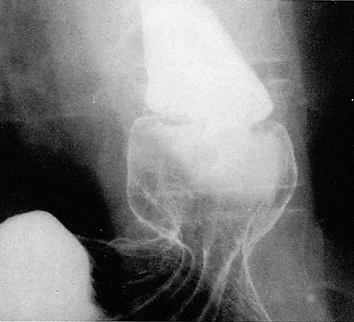 |
Figure 22.11 Lower esophageal mucosal ring (Schatzki's ring). The mucosal ring is outlined by the column of barium. |
Histology
The four layers that characterize the gastrointestinal tract mucosa, submucosa, muscularis propria, and serosa form the wall of the esophagus.
Mucosa
The mucosa consists of a nonkeratinizing, stratified squamous epithelium, lamina propria, and muscularis mucosae (Figure 22.12).
Epithelium
The squamous epithelium can be divided into the basal, prickle, and functional cell layers. In addition, argyrophilic positive endocrine cells, melanocytes, Merkel cells, intraepithelial antigen-presenting cells and intraepithelial lymphocytes that are virtually impossible to distinguish in routine sections (and therefore perhaps best called collectively intraepithelial mononuclear cells) can be found in the epithelium of the normal esophagus. The basal layer occupies approximately 10 to 15% of the epithelium, being one to three cells thick; however, in the distal 3 cm, approximately 60% of normal individuals (without objective or subjective evidence of gastroesophageal reflux) may show basal cell hyperplasia of greater than 15% (59,60). The upper extent of the basal zone has been arbitrarily defined as the level where the nuclei are separated by a distance equal to their diameter (61). Periodic acid-Schiff (PAS) stain may be used to demonstrate the upper extent of the glycogen-poor basal cells (Figure 22.13). Above the basal cell layer, the
P.573
prickle and functional cell layers consist of glycogen-rich cells that become progressively flatter toward the surface. Glandular mucosa of the distal esophagus is typical cardiac mucosa with variable numbers of specialized gastric cells and cardiac glands as described in the following chapter.
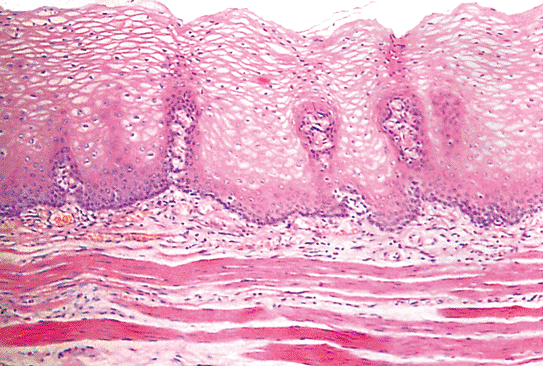 |
Figure 22.12 Midesophagus. The esophageal mucosa consists of a surface epithelial layer, middle lamina propria, and lower muscularis mucosae, which consists of longitudinally oriented smooth muscle bundles. |
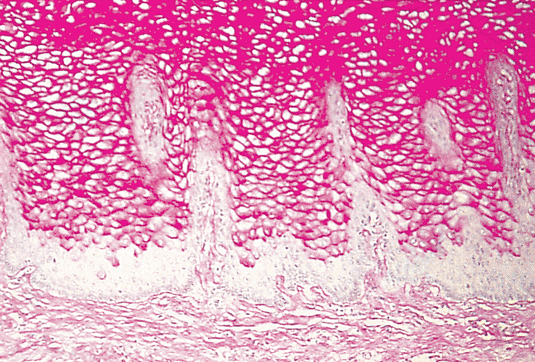 |
Figure 22.13 Midesophagus. The basal cell layer of the esophageal epithelium shows lack of glycogen, allowing for ready distinction from the overlying glycogen-rich cells (PAS-D). |
Argyrophilic positive endocrine cells and melanocytes have been found scattered among the basal cells in approximately 25% (62) and 4 to 8% of normal individuals, respectively, while Merkel cells are also described (29,30). The presence of melanocytes, referred to as melanosis (31,32,63), accounts for the occurrence of primary melanoma of the esophagus (64,65) and rare blue nevi (66), whereas the presence of argyrophilic positive cells accounts for the rare occurrence of pure small cell carcinoma (67).
Occasional lymphocytes are a normal finding in the epithelium and usually are located in a suprabasal location (68,69,70). As they interdigitate between the epithelial cells, their nuclei become convoluted and may be confused with the nuclei of neutrophils. The term squiggle cell, or intraepithelial cells with irregular nuclear contours, is used to describe this appearance (Figure 22.14). As in the rest of the gastrointestinal tract, intraepithelial lymphocytes are CD3+/CD8+, indicating suppressor/cytotoxic function. Langerhans cells, which are S-100+, CD6+, and CDla+, also are located in a suprabasal location (Figure 22.15); they function as antigen-presenting cells, similar to Langerhans cells of the skin (68,69).
 |
Figure 22.14 A. Numerous lymphocytes within the esophageal epithelium, some of which have a squiggle appearance (arrows). In addition, the intercellular spaces are dilated causing very prominent prickles, while some of these have formed small bubbles primarily at the junction between epithelial cells (best seen in the upper right quadrant). Care needs to be taken not to include perinuclear vacuolization/cytoplasmic retraction or paranuclear vacuoles as dilated intercellular spaces. B. Intraepithelial lymphocytes are of T-cell origin, as demonstrated using the T-cell marker UCHL-1, and are primarily suppressor (CD8+) cells. |
The cytology of the esophagus is represented by stratified squamous epithelium, gastric-type epithelium representing the distal 1 to 2 cm, and contaminants from the oropharynx, respiratory tract, and foreign material such as food particles. The squamous epithelium in cytologic material consists predominantly of superficial and intermediate squamous cells, with the deeper parabasal cells or squamous pearls occasionally observed. The gastric-type epithelium from the lower 1 to 2 cm of the esophagus is brushed as cohesive fragments of uniform cells displaying a honeycomb arrangement. The peripheral cells of the cluster are flattened. The nuclei are regular and paracentrally situated and contain a few granules of chromatin and occasionally a small nucleolus.
The electron microscopic appearance of the epithelial layer demonstrates similarities to nonkeratinizing squamous epithelium elsewhere (Figure 22.16). The cuboidal basal cells are attached to the basement membrane by hemidesmosomes. Progressing superficially, the epithelial cells become more flattened and the nuclei more pyknotic (68). Cell processes and desmosomes are most extensive in the prickle cell layer, becoming fewer and more simplified superficially (71). Membrane-bound, acid phosphatase containing structures measuring 200 to 300 nm in diameter are identified within the epithelial cells and are
P.574
postulated to have a lysosomal function, possibly involved in the digestion of cell junctions necessary for epithelial sloughing (71,72).
 |
Figure 22.15 Langerhans cell (arrow) in a suprabasal position (S-100). |
Cell kinetics of the human esophagus have not been studied extensively. The basal cells are responsible for epithelial regeneration; and, although data on human esophageal mucosal renewal are not available, epithelial turnover in the esophagus is slower than in the small bowel (73). In the mouse, basal cell proliferation has been shown to have a circadian rhythm (74), and the epithelial turnover time in the normal rat esophagus is approximately seven days (75). In patients with GERD, there is an increased proliferative activity of the basal cells, resulting in basal cell hyperplasia (76).
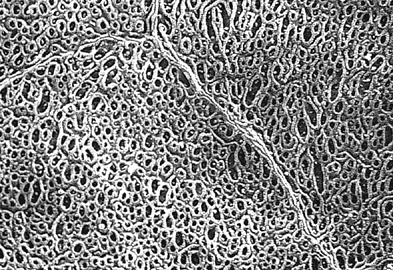 |
Figure 22.16 Scanning electron micrograph of the surface esophageal mucosa in which intercellular junctions are readily appreciated. |
Stem cells in the esophagus consist of a single layer of cells attached to the basement membrane that lie between the papillae (interpapillary basal cells) and have a low proliferative activity, being almost entirely Ki-67 (Figure 22.17). In animal models, when these cells divide, one remains attached to the basement membrane, while the
P.575
other migrates and differentiates. They therefore have a high proliferative capacity, divide relatively infrequently in vivo, and are phenotypically primitive. Under experimental conditions, such stem cells home to damaged esophagus, while it can also be shown that bone marrow derived cells can also home to the esophagus and differentiate into esophageal stem cells, including squamous epithelium (77). As such, basally situated stem cells do not show differentiation characteristics, possessing a different immunophenotype from the more differentiated cells in being CK13 immunoreactive; CK13 is expressed at high levels in the cells of both the papillary basal layer (PBL) and epibasal layers but is absent from the keratinocytes of the interpapillary basal layer (IBL). In addition, CK14 and CK15 are patchy in the IBL, which contrasts with the high levels of expression in the PBL and epibasal layers. Also, mRNA for the differentiation marker CK4 is detectable in the papillary region from the second epibasal layer onwards but does not appear in the interpapillary region until the third epibasal layer (78,79). Therefore, IBL cells appear to be the least differentiated cell type in the tissue (79). Suprabasal integrin expression is a consistent finding at the tips of the esophageal papillae, so PBL cells probably migrate to this site (80). This concept is illustrated in Figure 22.18.
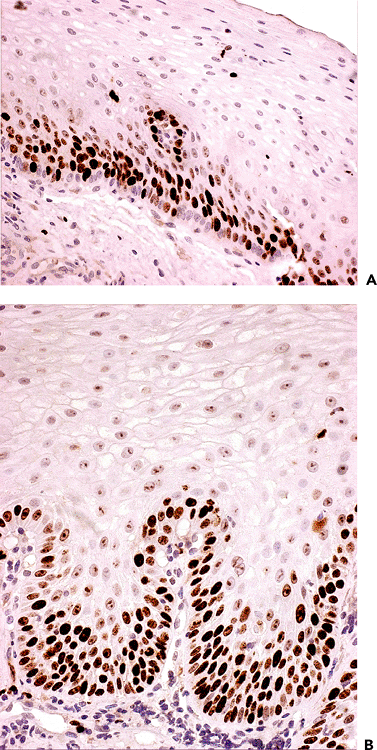 |
Figure 22.17 Basal layer of esophagus immunostained with MIB-1. A. The basal cell layer is relatively thin and unstimulated, consisting of only about 3 cell layers. Many of the cells in the basal layer are completely unstained, therefore representing likely stem cells, while the proliferating cells with black nuclei are in the cell layer immediately above. B. In this biopsy, the basal layer is much thicker and therefore more proliferative, and there are fewer noncycling stem cells in the basal layer. |
Lamina Propria
The lamina propria is the nonepithelial portion of the mucosa above the muscularis mucosae; it consists of areolar connective tissue and contains vascular structures, scattered inflammatory cells, and mucus-secreting glands. In adults, the presence of scattered inflammatory cells, including lymphocytes and plasma cells, is considered a normal finding and does not correlate with acid reflux (61). Lymphocytes identified in the lamina propria are both CD4+ and CD8+, with the T4 population predominating (68). Immunoglobulin (Ig)A-producing B cells (plasma cells) predominate, with a smaller population of IgG- and IgM-producing B cells (plasma cells) (68). Fingerlike extensions of lamina propria, termed papillae, extend into the epithelium, with the maximum depth of extension allowable in the normal esophagus varying from 50% (81) to 75% (81,82). Practically it is easy to use the rule of thirds when examining biopsies, in which papillae should not extend into the upper one-third, and basal cells should not get higher than halfway up the basal one-third (adapted from:
Ismail-Beigi F, Horton PF, Pope CE II. Histological consequences of gastroesophageal reflux in man. Gastroenterology 1970;58:163 174
). In the distal 3 cm of the esophagus, up to 60% of individuals without objective evidence of reflux demonstrate papillary lengths that may exceed these values (59). Conversely increasing basal cell hyperplasia and papillary height does correlate with increasing severity of reflux (83). |
Figure 22.18 A model of the cellular organization in the esophageal epithelium. The interpapillary basal layer (IBL) cells (blue-grey) constitute the epithelial stem cell compartment. IBL cells proliferate infrequently and asymmetrically. Proliferating cells reside in the epibasal (suprabasal) layers (blue). Papillary basal cells (PBL) (green) are proliferative and intermediate in behavior between IBL and epibasal cells (see text). Differentiated squamous cells are shown in orange. Modified with permission from: Seery JP, Watt FM. Asymmetric stem-cell divisions define the architecture of human oesophageal epithelium. Curr Biol 2000;10:1447 1450. |
Esophageal cardiac-type glands are diffusely scattered in the lamina propria through all levels of the esophagus, predominating in the distal and proximal regions (4,27). While they have been variably considered as heterotopias (7,27), normal constituents, or embryologic remnants, there is little doubt that they perform a lubricating function and are physiologically necessary to facilitate bolus passage. However their number is highly variable, and they are not always identified in the esophagus, having been found in 1 to 16% of esophagi in various studies (7,27,62). Histologically, these glands are located within the lamina propria, resemble the cardiac glands of the stomach, and are composed of cells secreting neutral mucins (Figure 22.19). They resemble pyloric glands, even to the extent that they are MUC6 immunoreactive, and may contain variable numbers of both parietal and chief cells and Paneth-like granules. Their ducts are lined by simple mucus-producing cells, in contrast to the submucosal gland ducts, that are frequently squamous-lined. These duct- lining cells may also extend onto the surface for a variable distance, even producing small islands of simple mucus-producing islands with an abrupt junction with squamous mucosa (H. Watanabe, personal communication).
Muscularis Mucosae
The muscularis mucosae is composed of smooth muscle bundles oriented longitudinally (42), rather than having both a circular and longitudinal arrangement as in the stomach and intestines. The muscularis mucosae begins at the cricoid cartilage of the pharynx and become thicker distally. At the gastroesophageal junction, the esophageal muscularis mucosae is thicker than that of the stomach and
P.576
P.577
may be so thick as to be mistaken for muscularis propria on biopsy (Figure 22.20). This thicker appearance, along with the longitudinal arrangement, is used sometimes to indicate an esophageal origin for the biopsy, and the differences between the muscularis mucosae of the stomach and esophagus can be used to identify the muscular gastroesophageal junction.
 |
Figure 22.19 Midesophagus. A. Esophageal cardiac-type glands are located within the lamina propria. The ducts are lined by gastric foveolar like cells. B. The duct-lining cells may extend over the stratified squamous epithelium for variable distances (PASD). C, D. The glands stained PASD positive and alcian blue at pH 2.5 negative, characteristic of neutral mucins. |
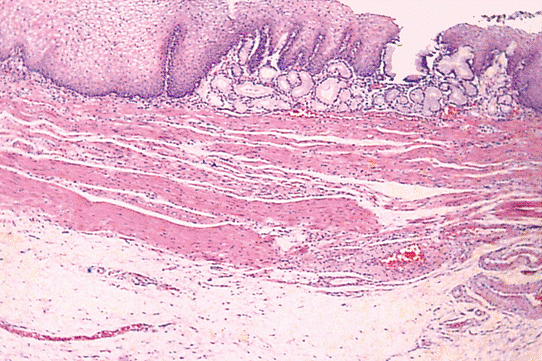 |
Figure 22.20 Distal esophagus. The mucosal layer at the gastroesophageal junction is characterized by muscularis mucosae that is thicker than the muscularis mucosae of the more proximal esophagus (compare with Figure 22.12). Note the esophageal cardiac-type gland situated above the muscularis mucosae. |
Submucosa
The submucosa consists of loose connective tissue containing vessels, nerve fibers (including Meissner's plexus), lymphatics, and submucosal glands (Figure 22.21). The submucosal glands are considered to be a continuation of the minor salivary glands of the oropharynx and are scattered throughout the entire esophagus, but they are more concentrated in the upper and lower regions (4). The glands consist of mucinous cells, with or without a minor serous component, and produce acid mucins (Figure 22.22)
P.578
as well as bicarbonate, which may have a local protective effect. The glands are drained by ducts, initially lined by a single layer of cuboidal epithelium, becoming stratified squamous in type, which penetrate the muscularis mucosae and epithelium to open into the esophageal lumen. This duct epithelium has been immunohistochemically shown to be CK14+/CK19+/CK7+/CK8/18+/variable CK20+ (84). This profile is similar to normal esophageal squamous epithelium and multilayered epithelium (ME), the latter representing a possible intermediate or early stage of Barrett's esophagus (84). Microscopic periductal aggregates of chronic inflammatory cells and duct dilatation are not uncommon findings in the normal esophagus (85). The presence of submucosal glands is indicative of an esophageal origin because these glands are not present in the stomach; unfortunately, submucosal glands are almost never present in mucosal biopsy specimens. However the ducts of the glands may be seen in the lamina propria of mucosal biopsies but are still only demonstrable in up to 14% of biopsies from the lower esophagus (86,87). Esophageal intramucosal pseudodiverticulosis is said to arise from postinflammatory obstruction of the ducts with subsequent duct dilatation (85,88).
 |
Figure 22.21 Midesophagus. Submucosal glands of the esophagus are located within the submucosa just beneath the muscularis mucosae. Periductal and periglandular chronic inflammation can be a normal finding. Note that in contrast to the columnar-lined glands of the lamina propria, the ducts of the submucosal glands are lined by squamous epithelium. |
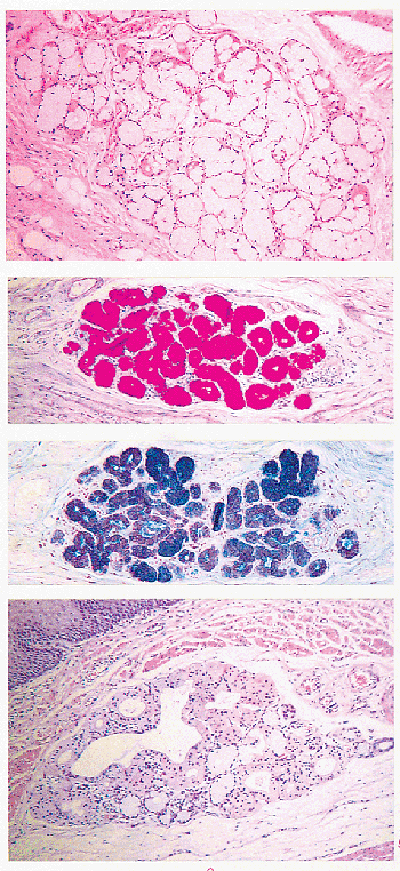 |
Figure 22.22 Midesophagus. A. The submucosal glands are composed predominantly of mucus-secreting cells with a variable serous component. B. and C. The submucosal glands stained positive with PAS-D and Alcian blue at pH 2.5, a characteristic of acid mucins. D. Submucosal glands may demonstrate oncocytic metaplasia. |
Muscularis Propria
It is generally stated that as much as the upper quarter to upper one-third of the proximal muscularis propria is composed of striated muscle (22,23); however, only a short length (approximately 5%) of the proximal muscularis propria is composed of striated muscle (89). Immediately distal to this, smooth and striated muscle intermix, with smooth muscle predominating, whereas slightly more than 50% of the distal muscularis propria is composed solely of smooth muscle (89) (Figure 22.23). Despite the presence of these two different muscle types, they can function as a unit. Auerbach's plexus is found between the two muscle layers. Disease processes may preferentially involve only one of the muscular layers, as in scleroderma (in which atrophy predominantly involves the circular layer) or in achalasia (in which the circular layer may become hypertrophied) (4).
Serosa
Only short segments of the thoracic and intra-abdominal esophagus are lined by serosa derived from the pleura and peritoneum, respectively (4). The majority of the esophagus is surrounded by fascia, which condenses around the esophagus, forming a sheathlike structure. In the upper mediastinum, the esophagus is given support as this fascial tissue extends out to surround and form a similar sheathlike arrangement around adjacent structures (22,23).
Arterial Supply
The cervical portion of the esophagus is supplied by branches of the inferior thyroid artery with contribution from various intercostal arteries. Branches of the bronchial arteries, intercostal arteries, and aorta supply the thoracic segment, whereas the abdominal segment is supplied by branches of the left gastric and inferior phrenic artery (4,22,23,90). Branches from these arteries run within the muscular layer, giving rise to branches that course within the submucosa. Anastomoses are extensive, explaining the rarity of esophageal infarction (4,90).
Venous Drainage
The venous return from the upper two-thirds of the esophagus drains into the inferior thyroid vein and azygous system, eventually reaching the superior vena cava. The lower esophageal segment drains into the systemic system through branches of the azygous vein and left inferior phrenic vein. The lower esophageal segment also drains into the portal system from branches of the left gastric vein and through the short gastric veins that empty into the splenic vein (4,22,23,90).
The anatomy of the lower esophageal system has been shown to consist of four layers (91). Radially arranged intraepithelial channels drain into the superficial venous plexus, which is found in the upper submucosa. This superficial venous plexus, consisting of three to five main trunks located in the lower submucosa, communicates with the deep intrinsic veins. Perforating veins connect this layer with the adventitial layer of veins located on the esophageal surface. The venous system appears to be mainly distributed within the esophageal mucosal folds (92).
The portal and caval systems communicate through the esophageal and gastric submucosal veins; and, with increased blood flow, as occurs in portal hypertension, all the venous channels of the normal esophagus dilate and are referred to as varices. In portal hypertension, varices are complicated by ulceration and rupture with hemorrhage. It has been suggested that a major variceal hemorrhage occurs as a result of rupture of a varix of the deep intrinsic veins, whereas minor variceal hemorrhages occur as a result of rupture of a varix in the superficial venous plexus or even from the intraepithelial channels (91).
Lymphatic Drainage
A rich network of lymphatics in the lamina propria and submucosa connect with lymphatics in the muscular and adventitial layers. Lymphatics in the muscular layer are predominantly oriented in a longitudinal direction (4). In
P.579
view of this longitudinal arrangement, extensive intramucosal and submucosal spread beyond a grossly visible tumor is not uncommon. This becomes an important consideration when assessing resection margins at frozen section.
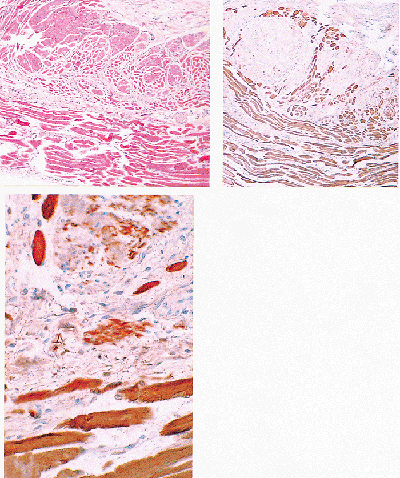 |
Figure 22.23 Proximal esophagus. A. The muscularis propria demonstrates a mixture of smooth and striated muscle bundles. B. This mix of smooth (weakly stained) and striated (strongly stained) muscle is demonstrated using a myoglobin antibody. C. Detail photomicrographs of myoglobin-stained section demonstrates peripherally located nuclei typical of striated muscle. |
In general, the cervical esophagus drains into the internal jugular and upper tracheal lymph node groups. The thoracic esophagus drains into the superior, middle, and lower mediastinal lymph node groups, whereas the abdominal segment drains into superior gastric, celiac axis, common hepatic artery, and splenic artery lymph nodes (93). Despite this drainage pattern, in practice the extensive communication of lymphatics results in a varied and unpredictable metastatic pattern (93).
Innervation (Nerves and Interstitial Cells of Cajal)
The esophagus receives both parasympathetic and sympathetic nerve supplies containing afferent and efferent fibers that innervate glands, blood vessels, and muscles of the esophagus. The vagus nerve carries both parasympathetic and some sympathetic fibers. Sympathetic fibers originating in cervical and paravertebral chains run with vascular structures and end at the esophagus.
As in the rest of the gastrointestinal tract, the esophagus has an intrinsic innervation system. This consists of ganglion cells in the submucosa (Meissner's plexus) and between the
P.580
circular and longitudinal muscle layers (Auerbach's plexus). These plexuses are less well developed in the esophagus when compared with the remainder of the gastrointestinal tract, and the density of neurons increases as one proceeds toward the stomach (22,23). The submucosal plexus is less well developed than the myenteric nerve plexus.
The plexuses of the esophagus receive input from postganglionic sympathetic and preganglionic and postganglionic parasympathetic fibers, as well as from other intrinsic ganglion cells (20). Three cell types are described in the plexuses (89). Type I neurons are multipolar and confined to Auerbach's plexus, and their axons establish synapses with type II cells. Type II neurons are more numerous, are multipolar, and are found in both Auerbach's and Meissner's plexuses. These cells supply the muscularis propria and muscularis mucosae and stimulate secretory activity.
Interstitial cells of Cajal (ICC) are widely distributed within the submucosal, intramuscular, and intermuscular layers associated with the terminal networks of sympathetic nerves. In the few studies that have examined the distribution of ICCs in the esophagus, they have been identified in the distal one-third of the esophagus in close association with smooth muscle, as well as in the middle one-third associated with both smooth and striated muscle (94). Gastrointestinal stromal tumors (GISTs), including those of esophageal origin, originate from these ICCs. Peculiar to the esophagus, when compared to the rest of the gastrointestinal tract, is that tumors of stromal origin are more frequently benign leiomyomas rather than GISTs (95).
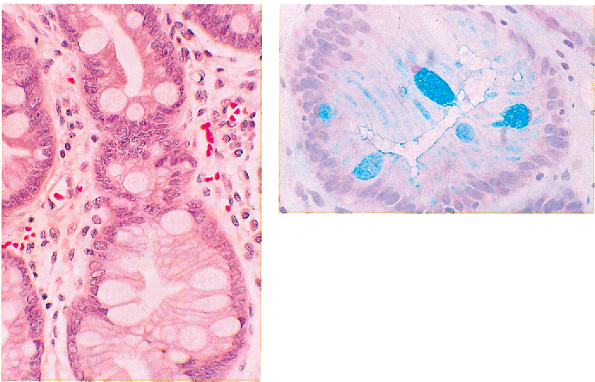 |
Figure 22.24 Barrett's esophagus. A. Intestinal metaplasia is recognized by the presence of goblet cells. Incomplete intestinal metaplasia (lower half of gland) is characterized by goblet cells associated with gastric foveolar like columnar cells, whereas complete intestinal metaplasia (upper half of gland) is characterized by goblet cells associated with small intestinal, absorptive-like columnar cells. B. Goblet cells in intestinal metaplasia stain positive with Alcian blue at pH 2.5. |
Regulatory peptides identified within nerve fibers and around smooth muscle bundles include vasoactive intestinal peptide (VIP), substance P, enkephalin, and neuropeptide Y (NPY) (96,97). Nerve fibers containing VIP and NPY are the most abundant types present in the esophagus, and the pattern of innervation by these peptide-containing neurons differs from that in the stomach and small intestine (98). Cholecystokinin (CCK) receptors are found in both the mucosa and nerves of the cardia (99).
Diagnostic Considerations
Commonly received biopsy specimens from the esophagus are for the diagnosis of reflux esophagitis or Barrett's esophagus. The problems of interpretation present in these cases involve the mucosal changes occurring primarily within the confines of the LES.
Barrett's Esophagus
Barrett's esophagus can be defined as the replacement of the esophageal squamous epithelium by metaplastic specialized (ideally intestinalized) columnar epithelium (100) (Figure 22.24). Both macroscopic and microscopic definitions exist, each proposed in an effort to address diagnostic problems encountered in this disease. That most accepted is the presence of an appropriate endoscopic
P.581
abnormality that is accompanied by intestinal metaplasia on biopsy (100). This works well except (a) in patients with a highly irregular Z line or very small tongues in whom the endoscopic interpretation of what is within normal limits (or not) may vary considerably; (b) in children, in whom it is rarely found in the first decade of life; and (c) tongues may also fail to yield goblet cells, especially in patients who have been on long-term proton pump inhibitors (PPIs). Indeed, fully 20% of patients rebiopsied for tongues yield goblet cells at the repeat endoscopy (51), a figure virtually identical to that described in long-segment disease (101). Little is known about the dynamics of goblet cells in Barrett's and, if the stimulus for their formation is removed (duodenogastroesophageal reflux) or the amount of gastric secretion reduced (e.g., by use of PPIs), whether their number may diminish or even disappear.
Macroscopically, Barrett's esophagus demonstrates a red velvety mucosa corresponding to the columnar epithelium, with an apparent focal or diffuse cephalad migration of the Z line relative to the previous normal mucosal gastroesophageal junction (Figure 22.25). Barrett's mucosa merges imperceptibly with the gastric mucosa distally. The junction with the esophageal squamous epithelium may appear as a symmetric or asymmetric Z line (as at the normal gastroesophageal junction) or as islands of columnar mucosa alternating with the squamous epithelium ( island pattern ). Foci of squamous epithelium occasionally are identified within Barrett's mucosa. Inflamed squamous mucosa may be indistinguishable from Barrett's mucosa endoscopically, and therefore also the squamo-Barrett junction, when both are present.
The diagnosis of Barrett's esophagus should always be confirmed histologically. If potential Barrett's mucosa is identified endoscopically, it should be examined via biopsy (as outlined below) to confirm the presence of specialized epithelium, as well as to exclude dysplasia or carcinoma, both of which may be inapparent endoscopically. Histologic confirmation is also important in cases of short-segment Barrett's esophagus (in which the short tongues of mucosa present may endoscopically resemble hiatal hernias, which are lined by gastric mucosa), inflammatory changes at the gastroesophageal junction, or an exaggerated and asymmetric yet normal mucosal gastroesophageal junction (102,103,104). Histologic confirmation is also necessary in cases of suspected childhood Barrett's esophagus, where Barrett's mucosa may be indistinguishable from the normal squamous epithelium (105,106,107). While the term ultra-short Barrett's esophagus has been used, primarily for lesions less that 1 cm (108), the interobserver variability of when an irregular Z line stops and Barrett's starts is problematic, rendering the term relatively useless. There also seems little sense in using it for patients with just intestinal metaplasia in an apparently normal cardia.
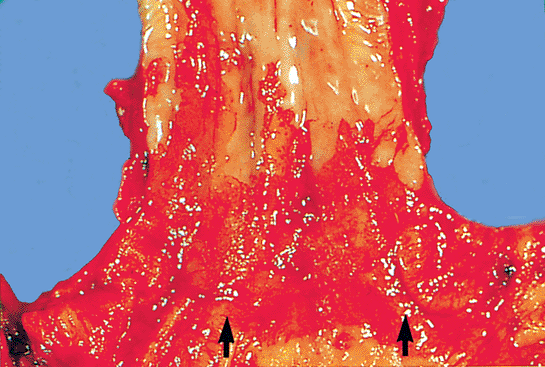 |
Figure 22.25 Gastroesophageal region. Barrett's esophagus, demonstrating proximal extension of columnar-lined mucosa well into the tubular esophagus. This columnar-lined mucosa extends more than 2 cm from the proximal gastric folds (arrows). |
In adults, specialized epithelium is by far the most frequent epithelial type identified, so much so that the presence of this epithelium is increasingly being used as the sole criterion for the diagnosis of Barrett's esophagus (100). Other epithelial types are of much less value diagnostically and include fundic, junctional, metaplastic pancreatic acinar, and multilayered epithelium. Superimposed dysplasia, primarily of intestinalized epithelium, also may be present.
Specialized-type epithelium is characterized by the presence of goblet and columnar cells (Figure 22.24). The goblet cells contain acid mucins, predominantly sialomucins, thus staining positive with Alcian blue at pH 2.5, MUC2, or CD10 if there is complete intestinal metaplasia. The nongoblet cell population may also show an intestinal phenotype, showing expression of the intestinal markers sucrase-isomaltase and dipeptidilpeptidase IV immunoexpression in the majority of patients examined (109). Similarly goblet cells in Barrett's associated intestinal metaplasia are much more likely to express the mucin antigens MUC1 and MUC6 (110). The columnar epithelial cells may therefore resemble either small intestinal absorptive cells (complete intestinal metaplasia) or gastric foveolar cells, which frequently show evidence of an intestinal phenotype (incomplete intestinal metaplasia); however, these metaplastic cells demonstrate abnormal features that distinguish them from their normal counterparts (Figure 22.24). In the case of complete intestinal metaplasia, the small intestinal-like columnar cells may demonstrate a brush border, but it is not well developed and lacks the uniform enzymatic activity normally found in the brush border of the small intestine (111). Ultrastructurally, these metaplastic cells have been shown to contain mucin granules, which are not present in the absorptive cells of the small intestine, while the gastric foveolar-like columnar cells frequently contain Alcian blue positive acid mucin, in contrast to those that normally populate the stomach, which contain Alcian blue negative neutral mucins (111).
P.582
Other types of gastric mucosa may be present in Barrett's esophagus but cannot easily be distinguished from mucosa arising from the normal gastric cardiac mucosa; their definitive presence in Barrett's esophagus can be accepted only in resections or other circumstances under which specialized mucosa has been identified above the gastroesophageal junction. In the adult, fundic-type mucosa is uncommon and, if present, resembles the transitional epithelium seen at the junction of the gastric body with the antrum or cardia, with only a scattering of parietal and chief cells. Fundic-type mucosa without intestinalization and resembling normal gastric fundus mucosa can be seen in childhood Barrett's esophagus; otherwise, it is rare, and if present one must consider the possibility that the invariably present hiatal hernia has been examined via biopsy. The lack of intestinalized mucosa is a feature usually confined to children; it is likely that specialization occurs later in early adult life. Similarly, junctional-type mucosa that histologically is indistinguishable from normal gastric cardiac mucosa may be present so much so that, if seen as the only mucosal type in a case of suspected short-segment Barrett's esophagus, a normal exaggerated Z line cannot be excluded.
Multilayered epithelium is a distinctive type of epithelium, histologically characterized by multiple layers of basaloid cells with an overlying layer of columnar epithelium (Figure 22.26). This epithelium has been shown to have mucin and immunohistochemical qualities similar to normal squamous epithelium, duct gland epithelium, and Barrett's epithelium (84); and it is associated with reflux-induced injury (112) and intestinal metaplasia in patients with Barrett's disease (113). As such, it is postulated that multilayered epithelium may represent an early/transitional phase of columnar metaplasia in Barrett's esophagus, although some believe that this is ciliated ultrastructurally and therefore represents simple metaplasia (8,28).
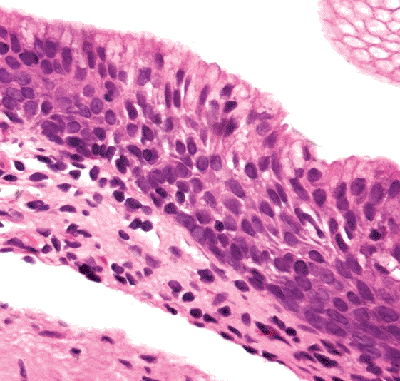 |
Figure 22.26 Multilayered epithelium, in which there is apical mucin production at the luminal surface (top), but the remainder of the epithelium appears squamous with intercellular bridges. |
The diagnosis of Barrett's esophagus is best established by taking biopsy samples from various levels of the gastroesophageal region (114), beginning in the stomach just distal to the upper end of the gastric folds, ideally along the lesser curve, and then every 1 to 2 cm, up into the tongues of mucosa or the most irregular portion of the squamocolumnar junction until squamous epithelium is reached. Obvious islands of columnar-lined epithelium also should be examined via biopsy. This series of biopsy samples yields tissue that initially originates in a site that is clearly of gastric origin (thereby excluding gastric intestinal metaplasia as a cause of proximal intestinalized epithelium), continues through mucosa in which intestinalized epithelium is present (thereby confirming the diagnosis of Barrett's esophagus), and finishes in squamous mucosa. Intestinal metaplasia may be focal and thus may be missed on biopsy. In such cases, if the diagnosis of Barrett's esophagus is suspected, follow-up with repeat biopsy is necessary.
Although there is uncertainty as to the cell of origin for Barrett's esophagus, the cells lining the gland duct may be considered as a possible source (115). Conversely, re-epithelialization of the esophagus following ablation may well be from the squamous-lined submucosal gland ducts.
Intestinal Metaplasia Limited to the Cardiac Region
Intestinal metaplasia (IM) is common and found in up to one-third of patients (116); but, it also depends to some extent on how many biopsies are taken and where a highly irregular but normal Z line stops and short-segment Barrett's esophagus (defined as less than 3 cm of columnar-lined esophagus with goblet cells) begins, a feature with quite marked interobserver variability. In one study, a total of 811 (84.6%) patients had 0 to 0.9 cm of questionably abnormal columnar epithelium between normal oxyntic mucosa and squamous epithelium. Of these, 161 (19.9%) patients had no abnormal epithelium, 158 (19.4%) patients had oxyntocardiac mucosa, 372 (45.9%) patients had cardiac mucosa, and 120 (14.8%) patients had intestinal metaplasia. The prevalence of intestinal epithelium increased progressively with increasing length of abnormal columnar epithelium, being present in 70.4% in the 1- to 2-cm group, 89.5% in the 3- to 4-cm group, and 100% within the greater than or equal to 5 cm group (117).
This raises several issues. First, metaplasia has several causes, although the principle two are GERD and Helicobacter. Second, because the diagnosis of Barrett's esophagus requires both intestinal metaplasia and an appropriate endoscopic appearance, the identification becomes key, especially in defining what is unequivocally
P.583
abnormal and where an irregular but normal Z line stops and Barrett's begins (118,119). Clearly, Barrett's esophagus has to begin somewhere, but this distinction is currently impossible to determine because, although some differences between metaplasia in native cardiac mucosa and metaplasia in what was formerly squamous mucosa exist (9), it is unclear how reliable these are. The third issue regarding the type of epithelium in which intestinal metaplasia is occurring is in part the pathogenesis issue but also its implication. Does intestinal metaplasia in what is believed to be the native cardiac side of the Z line have the same malignant potential as recognized Barrett's mucosa? If it does not, then it becomes critical to attempt to separate the two; but, if it does, then the exercise is futile because both diseases are premalignant and the issue becomes the extent of the risk and whether this justifies surveillance. Because metaplasia at the cardia in Helicobacter gastritis tends to be complete, while that in Barrett's is often both complete and incomplete, it is likely that Barrett's esophagus is at increased risk of developing carcinoma. This is also supported by mucin immunohistochemistry using MUC1 and MUC6 (110).
Gastroesophageal Reflux Disease (GERD)
The problems encountered in GERD are related to squamous epithelial changes in the distal 3 cm of the esophagus and to the significance of intraepithelial inflammatory cells.
Reactive Squamous Changes
Reflux-associated squamous hyperplasia (RASH) consists of basal cell hyperplasia of greater than 15% and extension of the papillae into the upper one-third of the epithelium (60) (Figure 22.27). Practically, in well-oriented biopsy samples, the esophageal mucosa can be divided into thirds; the papillae should not be seen extending into the upper one-third, and the basal cell layer should not extend more than halfway into the lower one-third. This is operatively a simple and rapid technique for assessing the degree of RASH. However, similar changes have been described in the distal 3 cm of the esophagus in approximately 60% of patients without objective or subjective evidence of acid reflux (59); thus, if present in biopsy samples originating from this zone, such hyperplastic changes should be considered normal, despite the fact that these changes are much more likely to be found in patients with GERD and NERD (nonerosive reflux disease) (83). Changes of RASH are much more likely to be a more specific indicator of reflux if the biopsy samples are taken above the distal 3 cm of the esophagus (59,61). It should be remembered that squamous hyperplasia is a nonspecific reaction to any form of esophageal injury and needs to be interpreted in light of the clinical context.
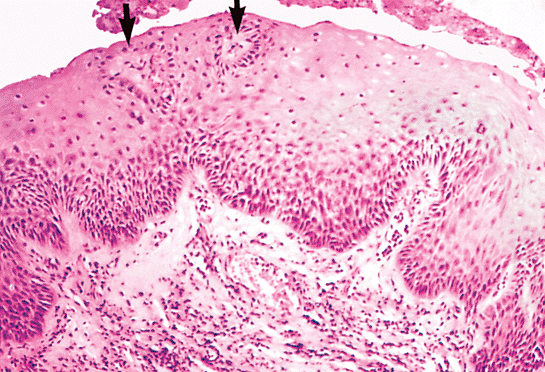 |
Figure 22.27 Reflux esophagitis. Basal cell hyperplasia and lengthening of the papillae are present. The papillae have extended almost to the surface of the mucosa (arrows). |
Dilated Intercellular Spaces
Apart from squmaous hyperplasia, dilatation of the intercelluar spaces of the squamous epithelium as a result of gastroesophageal reflux has been demonstrated at both the electron and light microscopic level (120,121,122) (Figure 22.14). This early epithelial damage is morphologically characterized by irregular dilatation of the intercellular spaces of the basal and prickle cell layers in both erosive and nonerosive esophagitis. Using ultrastructural measurement, it seems that dilatation of more than 2.4 m is highly suggestive of GERD (123). This is approximately half the diameter of an intaepithelial lymphocyte. Further, patients with NERD have a DIS measurement of approximately half of this at 1.5 m, which is still about three times the normal value of 0.45 to 0.5 m (124). Readers will no doubt be pleased to know that these measurements were made ultrastructurally! Treatment with omeprazole results in complete recovery of DIS (125). DIS have also been shown to be one of the histological changes (along with basal cell hyperplasia) seen in biopsies from endoscopic lesions referred to as red streaks (86), along with newly re-epithelialized lesions or granulation tissue beneath squamous epithelium. Its utility as a marker of GERD when unaccompanied by other morphological features of reflux disease has yet to be fully determined.
Intraepithelial Inflammatory Cells
Intraepithelial eosinophils (IEEs) and intraepithelial neutrophils (IENs) are generally not considered to be normal constituents of the epithelium throughout its entire length, although rare IEEs in the distal 3 cm of approximately one-third of adult patients is considered normal (61). The presence of IEEs has long been considered a sensitive indicator
P.584
of reflux esophagitis (61,82,126), although this sensitivity is in question, and not infrequently it is the only pathologic change (Figure 22.28A). Intraepithelial eosinophils are not absolutely specific, having been described in esophagitis due to alkaline reflux, allergic disorders, and infections (82) (Figure 22.28B). In children, although not an absolute criterion, eosinophils within the lamina propria are a significant finding in GERD. However, it is also clear that there is a second syndrome that can be seen in both adults and children in whom the primary symptom may be dysphagia rather than GERD; it tends to occur in younger males, and when fully developed is characterized endoscopically by rings reminiscent of allergic esophagitis. It has therefore been called feline esophagus, ringed esophagus, or trachealization of the esophagus. The esophagus is fragile and can perforate if dilatation of areas of narrowing is attempted. Histologically, the features are massive (usually 20 40/HPF) numbers of eosinophils, that also tend to extend throughout the esophagus, and also tend to be superficial. Patients often have other evidence of allergies and may respond to steroids or allergen withdrawal, including an elemental diet, rather than to PPIs (127,128,129,130,131,132,133).
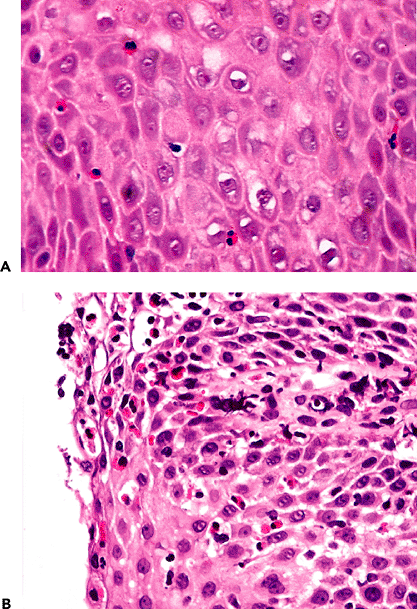 |
Figure 22.28 Eosinophilic esophagitis. A. Reflux esophagitis. Intraepithelial eosinophils are present between the epithelial cells. B. Allergic esophagitis (feline esophagus). There is marked basal cell hyperplasia, spongiosis with dilated intercellular spaces, and numerous eosinophils. |
The presence of IENs obviously implies acute esophagitis and correlates with the presence of erosion or ulceration, albeit of any cause, but is less sensitive for mild GERD. When present, IENs are frequently, but not always, accompanied by the other histologic features of esophagitis. In biopsies, the absence of other features may simply reperesent sampling problems. The use of DIS, IEEs, and IENs as histologic criteria of GERD has the advantage that localization and orientation of the biopsy is not important.
Vascular changes such as dilated capillaries and extravasated red blood cells in the lamina propria should not be considered as criteria for GERD (60,61), although some have been impressed by its usefulness (134). Increased vascularization in the lamina propria, thought of as indicative of RASH is not considered a diagnostic criterion (133). The presence of intraepithelial mononuclear cells (squiggle cells) is associated with GERD but rarely used as the sole criterion (83,135,136).
In the assessment of biopsy tissues for RASH, well-oriented biopsy specimens of full epithelial thickness are necessary. Quite often biopsy samples are taken with small pinch forceps, resulting in a specimen that is small, superficial, and difficult to orient. If endoscopy is being performed to obtain a tissue diagnosis, an appropriate endoscope with large-particle grasp forceps should be used. Changes of GERD may have a patchy distribution; thus, multiple biopsies are recommended. It is important to avoid the use of picric acid containing dyes and fixatives (such as Bouin's solution) because this interferes with the staining of the eosinophil granules, thus preventing their recognition.
Inflammatory Changes on the Cardiac Side of the Z Line
Because of the increasing use of biopsy samples immediately on the squamous side of the Z line to detect inflammatory cells, some biopsy samples inevitably contained cardiac mucosa immediately distal to the Z line. Some of these specimens contained an excess of chronic and sometimes acute inflammatory changes, which were not only unaccompanied by inflammatory changes elsewhere in the stomach, as might be expected with Helicobacter pylori gastritis, but inflammation appeared to be completely limited to the gastric cardia and therefore was appropriately termed gastric carditis (114). However, it appears to be a more sensitive marker for GERD than inflammatory changes in the squamous mucosa, as judged by correlation with 24-hour pH studies (57,114,137,138), the proviso being that Helicobacter infection (gastritis) is not present as this also causes carditis (139,140,141).
P.585
Adenocarcinomas of the Gastroesophageal Region
Adenocarcinomas arising in the gastroesophageal region may have their origin from the gastric cardia, from Barrett's mucosa, or theoretically from the gastric cardiac-type mucosa present in the distal 2 cm of the esophagus. Gastric cardiac adenocarcinomas can be defined macroscopically as those occurring at or below the gastroesophageal junction, with the bulk of the tumor found in the gastric cardia and not involving the body or distal stomach (142). The presence of premalignant changes in the adjacent cardiac epithelium, such as a villous adenoma or dysplasia, would be confirmatory. Adenocarcinoma arising from Barrett's esophagus are predominantly located in the esophagus and are usually associated with demonstrable Barrett's mucosa histologically. Those arising from the gastric epithelium of the distal 2 cm of the esophagus can be classified with those of the gastric cardia unless associated with Barrett's mucosa. Occasionally, an adenocarcinoma may involve both the lower esophagus and gastric cardia equally, with obliteration of the landmarks of the gastroesophageal junction and any premalignant mucosa. In these cases, identification of the site of origin may be impossible; however, from a practical viewpoint, this distinction may not be important because their clinical behaviors are similar (142,143,144).
Acknowledgment
We thank Dr. G. W. Stevenson for radiographic material.
References
1. Vaage S, Knutrud O. Congenital duplications of the alimentary tract with special regard to their embryogenesis. Prog Pediatr Surg 1974;7:103 123.
2. Johns BA. Developmental changes in the oesophageal epithelium in man. J Anat 1952;86:431 442.
3. Berardi RS, Devaiah KA. Barrett's esophagus. Surg Gynecol Obstet 1983;156:521 538.
4. Enterline H, Thompson J. Pathology of the Esophagus. New York: Springer-Verlag; 1984.
5. Borrelli O, Hassall E, D'Armiento F, et al. Inflammation of the gastric cardia in children with symptoms of acid peptic disease. J Pediatr 2003;143:520 524.
6. Chandrasoma P, Makarewicz K, Wickramasinghe K, Ma Y, Demeester T. A proposal for a new validated histological definition of the gastroesophageal junction. Hum Pathol 2006;37:40 47.
7. Rector LE, Connerley ML. Aberrant mucosa in the esophagus in infants and children. Arch Pathol 1941;31:285 294.
8. Takubo K, Vieth M, Honma N, et al. Ciliated surface in the esophagogastric junction zone: a precursor of Barrett's mucosa or ciliated pseudostratified metaplasia? Am J Surg Pathol 2005;29:211 217.
9. Wallace AS, Burns AJ. Development of the enteric nervous system, smooth muscle and interstitial cells of Cajal in the human gastrointestinal tract. Cell Tissue Res 2005;319:367-82.
10. Le Roux BT. Intrathoracic duplication of the foregut. Thorax 1962;17:357 362.
11. Tarnay TJ, Chang CH, Nugent RG, Warden HE. Esophageal duplication (foregut cyst) with spinal malformation. J Thorac Cardiovasc Surg 1970;59:293 298.
12. Abell MR. Mediastinal cysts. AMA Arch Pathol 1956;61:360 379.
13. Rosenthal AH. Congenital atresia of the esophagus with tracheoesophageal fistula. Report of eight cases. Arch Pathol 1931;12:756 772.
14. Strobel CT, Byrne WJ, Ament ME, Euler AR. Correlation of esophageal lengths in children with height: application to the Tuttle test without prior esophageal manometry. J Pediatr 1979;94:81 84.
15. Greene FL, Page DL, Fleming ID, et al. Esophagus. In: Greene FL, Page DL, Fleming ID, et al., eds. AJCC Cancer Staging Manual. 6th ed. New York: Springer; 2002:91 98.
16. Abid S, Mumtaz K, Jafri W, et al. Pill-induced esophageal injury: endoscopic features and clinical outcomes. Endoscopy 2005;37:740 744.
17. Gulsen MT, Buyukberber NM, Karaca M, Kadayifci A. Cyproterone acetate and ethinylestradiol-induced pill oesophagitis: a case report. Int J Clin Pract Suppl 2005;147:79 81.
18. McCullough RW, Afzal ZA, Saifuddin TN, Alba LM, Khan AH. Pill-induced esophagitis complicated by multiple esophageal septa. Gastrointest Endosc 2004;59:150 152.
19. Marshall JB, Singh R, Demmy TL, Bickel JT, Everett ED. Mediastinal histoplasmosis presenting with esophageal involvement and dysphagia: case study. Dysphagia 1995;10:53 58.
20. Feldman M, Friedman LS, Sleisenger MH. Sleisenger and Fordtran's Gastrointestinal and Liver Disease: Pathophysiology, Diagnosis and Management. 7th ed. Philadelphia: WB Saunders; 2002:549 671.
21. Bombeck CT, Dillard DH, Nyhus LM. Muscular anatomy of the gastroesophageal junction and the role of phrenoesophageal ligament. Autopsy study of sphincter mechanism. Ann Surg 1966;164:643 654.
22. Netter FH, ed. The CIBA Collection of Medical Illustrations: A Compilation of Pathological and Anatomical Paintings. Vol 3. Digestive System. Part I: Upper Digestive Tract. Summit, NJ: CIBA-Geigy; 1957.
23. Netter FH. Atlas of Human Anatomy. 3rd ed. St. Louis: ICDH Learning/Elsevier; 2003.
24. Katagiri A, Kaneko K, Konishi K, Ito H, Kushima M, Mitamura K. Lugol staining pattern in background epithelium of patients with esophageal squamous cell carcinoma. Hepatogastroenterology 2004;51:713 717.
25. McGarrity TJ, Wagner Baker MJ, Ruggiero FM, et al. GI polyposis and glycogenic acanthosis of the esophagus associated with PTEN mutation positive Cowden syndrome in the absence of cutaneous manifestations. Am J Gastroenterol 2003;98:1429 1434.
26. Vadva MD, Triadafilopoulos G. Glycogenic acanthosis of the esophagus and gastroesophageal reflux. J Clin Gastroenterol 1993;17:79 83.
27. Tang P, McKinley MJ, Sporrer M, Kahn E. Inlet patch: prevalence, histologic type, and association with esophagitis, Barrett esophagus, and antritis. Arch Pathol Lab Med 2004;128:444 447.
28. Takubo K, Honma N, Arai T. Multilayered epithelium in Barrett's esophagus. Am J Surg Pathol 2001;25:1460 1461.
29. Harmse JL, Carey FA, Baird AR, et al. Merkel cells in the human oesophagus. J Pathol 1999;189:176 179.
30. Tateishi R, Taniguchi K, Horai T, Iwanaga T, Taniguchi H. Argyrophil cell carcinoma (apudoma) of the esophagus. A histopathologic entity. Virchows Arch A Pathol Anat Histol 1976;371:283 294.
31. Ohashi K, Kato Y, Kanno J, Kasuga T. Melanocytes and melanosis of the oesophagus in Japanese subjects analysis of factors effecting their increase. Virchows Arch A Pathol Anat Histopathol 1990;417:137 143.
32. Bogomoletz WV, Lecat M, Amoros F. Melanosis of the oesophagus in a Western patient. Histopathology 1997;30:498 499.
33. Yamazaki K, Ohmori T, Kumagai Y, Makuuchi H, Eyden B. Ultrastructure of oesophageal melanocytosis. Virchows Arch A Pathol Anat Histopathol 1991;418:515 522.
34. Abe T, Hosokawa M, Kusumi T, et al. Adenocarcinoma arising from ectopic gastric mucosa in the cervical esophagus. Am J Clin Oncol 2004;27:644 645.
P.586
35. Hirayama N, Arima M, Miyazaki S, et al. Endoscopic mucosal resection of adenocarcinoma arising in ectopic gastric mucosa in the cervical esophagus: case report. Gastrointest Endosc 2003;57:263 266.
36. Nakanishi Y, Ochiai A, Shimoda T, et al. Heterotopic sebaceous glands in the esophagus: histopathological and immunohistochemical study of a resected esophagus. Pathol Int 1999;49:364 368.
37. Kushima R, von Hinuber G, Lessel W, Stolte M, Borchard F. Sebaceous gland metaplasia in cardiac-type mucosa of the oesophago-gastric junction. Virchows Arch 1996;428:297 299.
38. Postlethwait RW, Detmer DE. Ectopic thyroid nodule in the esophagus. Ann Thorac Surg 1975;19:98 100.
39. Polkowski W, van Lanschot JJ, ten Kate FJ, et al. Intestinal and pancreatic metaplasia at the esophagogastric junction in patients without Barrett's esophagus. Am J Gastroenterol 2000;95:617 625.
40. Popiolek D, Kahn E, Markowitz J, Daum F. Prevalence and pathogenesis of pancreatic acinar tissue at the gastroesophageal junction in children and young adults. Arch Pathol Lab Med 2000;124:1165 1167.
41. Krishnamurthy S, Dayal Y. Pancreatic metaplasia in Barrett's esophagus. An immunohistochemical study. Am J Surg Pathol 1995;19:1172 1180.
42. Goyal RK. Columnar cell-lined (Barrett's) esophagus: a historical perspective. In: Spechler SJ, Goyal RK, eds. Barrett's Esophagus: Pathophysiology, Diagnosis and Management. New York: Elsevier; 1985:1 18.
43. Goyal RK. The lower esophageal sphincter. Viewpoints Dig Dis 1976;8:1 4.
44. van Overbeek JJ. Pathogenesis and methods of treatment of Zenker's diverticulum. Ann Otol Rhinol Laryngol 2003;112:583 593.
45. Theisen J, Oberg S, Peters JH, et al. Gastro-esophageal reflux disease confined to the sphincter. Dis Esophagus 2001;14:235 238.
46. Wolf C, Timmer R, Breumelhof R, Seldenrijk CA, Smout AJ. Prolonged measurement of lower oesophageal sphincter function in patients with intestinal metaplasia at the oesophagogastric junction. Gut 2001;49:354 358.
47. Liebermann-Meffert D, Allgower M, Schmid P, Blum A. Muscular equivalent of the lower esophageal sphincter. Gastroenterology 1979;76:31 38.
48. Jamieson J, Hinder RA, DeMeester TR, Litchfield D, Barlow A, Bailey RT Jr. Analysis of thirty-two patients with Schatzki's ring. Am J Surg 1989;158:563 566.
49. Mitre MC, Katzka DA, Brensinger CM, Lewis JD, Mitre RJ, Ginsberg GG. Schatzki ring and Barrett's esophagus: do they occur together? Dig Dis Sci 2004;49:770 773.
50. McClave SA, Boyce HW Jr, Gottfried MR. Early diagnosis of columnar-lined esophagus: a new endoscopic diagnostic criterion. Gastrointest Endosc 1987;33:413 416.
51. Jones TF, Sharma P, Daaboul B, et al. Yield of intestinal metaplasia in patients with suspected short-segment Barrett's esophagus (SSBE) on repeat endoscopy. Dig Dis Sci 2002;47:2108 2111.
52. Hoshihara Y, Kogure T, Yamamoto T, Hashimoto M, Hoteya O. Endoscopic diagnosis of Barrett's esophagus [article in Japanese]. Nippon Rinsho 2005;63:1394 1398.
53. Choi do W, Oh SN, Baek SJ, et al. Endoscopically observed lower esophageal capillary patterns. Korean J Intern Med 2002;17:245 248.
54. Chandrasoma P. Histopathology of the gastroesophageal junction: a study on 36 operation specimens. Am J Surg Pathol 2003;27:277 278.
55. Zhou H, Greco MA, Daum F, Kahn E. Origin of cardiac mucosa: ontogenic consideration. Pediatr Dev Pathol 2001;4:358 363.
56. Chandrasoma PT, Lokuhetty DM, Demeester TR, et al. Definition of histopathologic changes in gastroesophageal reflux disease. Am J Surg Pathol 2000;24:344 351.
57. Der R, Tsao-Wei DD, Demeester T, et al. Carditis: a manifestation of gastroesophageal reflux disease. Am J Surg Pathol 2001;25:245 252.
58. Goyal RK, Bauer JL, Spiro HM. The nature and location of lower esophageal ring. N Engl J Med 1971;284:1175 1180.
59. Weinstein WM, Bogoch ER, Bowes KL. The normal human esophageal mucosa: a histological reappraisal. Gastroenterology 1975;68:40 44.
60. Ismail-Beigi F, Horton PF, Pope CE II. Histological consequences of gastroesophageal reflux in man. Gastroenterology 1970;58:163 174.
61. Groben PA, Siegal GP, Shub MD, Ulshen MH, Askin FB. Gastroesophageal reflux and esophagitis in infants and children. Perspect Pediatr Pathol 1987;11:124 151.
62. De La Pava S, Nigogosyan G, Pickren JW, Cabrera A. Melanosis of the esophagus. Cancer 1963;16:48 50.
63. Sharma SS, Venkateswaran S, Chacko A, Mathan M. Melanosis of the esophagus. An endoscopic, histochemical, and ultrastructural study. Gastroenterology 1991;100:13 16.
64. Awsare M, Friedberg JS, Coben R. Primary malignant melanoma of the esophagus. Clin Gastroenterol Hepatol 2005;3:xxvii.
65. Suzuki Y, Aoyama N, Minamide J, Takata K, Ogata T. Amelanotic malignant melanoma of the esophagus: report of a patient with recurrence successfully treated with chemoendocrine therapy. Int J Clin Oncol 2005;10:204 207.
66. Lam KY, Law S, Chan GS. Esophageal blue nevus: an isolated endoscopic finding. Head Neck 2001;23:506 509.
67. Saint Martin MC, Chejfec G. Barrett esophagus-associated small cell carcinoma. Arch Pathol Lab Med 1999;123:1123.
68. Seefeld U, Krejs GJ, Siebenmann RE, Blum AL. Esophageal histology in gastroesophageal reflux. Morphometric findings in suction biopsies. Am J Dig Dis 1977;22:956 964.
69. Geboes K, De Wolf-Peeters C, Rutgeerts P, Janssens J, Vantrappen G, Desmet V. Lymphocytes and Langerhans cells in the human oesophageal epithelium. Virchows Arch A Pathol Anat Histopathol 1983;401:45 55.
70. Geboes K, Haot J, Mebis J, Desmet VJ. The histopathology of reflux esophagitis. Acta Chir Belg 1983;83:444 448.
71. Hopwood D, Logan KR, Bouchier IA. The electron microscopy of normal human oesophageal epithelium. Virchows Arch B Cell Pathol 1978;26:345 358.
72. Geboes K, Desmet V. Histology of the esophagus. Front Gastrointest Res 1978;3:1 17.
73. Bell B, Almy TP, Lipkin M. Cell proliferation kinetics in the gastrointestinal tract of man. 3. Cell renewal in esophagus, stomach, and jejunum of a patient with treated pernicious anemia. J Natl Cancer Inst 1967;38:615 628.
74. Burns ER, Scheving LE, Fawcett DF, Gibbs WM, Galatzan RE. Circadian influence on the frequency of labeled mitoses method in the stratified squamous epithelium of the mouse esophagus and tongue. Anat Rec 1976;184:265 273.
75. Eastwood GL. Gastrointestinal epithelial renewal. Gastroenterology 1977;72(pt 1):962 975.
76. Livstone EM, Sheahan DG, Behar J. Studies of esophageal epithelial cell proliferation in patients with reflux esophagitis. Gastroenterology 1977;73:1315 1319.
77. Epperly MW, Guo H, Shen H, et al. Bone marrow origin of cells with capacity for homing and differentiation to esophageal squamous epithelium. Radiat Res 2004;162:233 240.
78. Viaene AI, Baert JH. Expression of cytokeratin mRNAs in normal human esophageal epithelium. Anat Rec 1995;241:88 98.
79. Seery JP. Stem cells of the oesophageal epithelium. J Cell Sci 2002;115(pt 9):1783 1789.
80. Seery JP, Watt FM. Asymmetric stem-cell divisions define the architecture of human oesophageal epithelium. Curr Biol 2000;10:1447 1450.
81. Goldman H, Antonioli DA. Mucosal biopsy of the esophagus, stomach, and proximal duodenum. Hum Pathol 1982;13:423 448.
82. Brown LF, Goldman H, Antonioli DA. Intraepithelial eosinophils in endoscopic biopsies of adults with reflux esophagitis. Am J Surg Pathol 1984;8:899 905.
83. Vieth M, Peitz U, Labenz J, et al. What parameters are relevant for the histological diagnosis of gastroesophageal reflux disease without Barrett's mucosa? Dig Dis 2004;22:196 201.
84. Brien TP, Farraye FA, Odze RD. Gastric dysplasia-like epithelial atypia associated with chemoradiotherapy for esophageal cancer: a clinicopathologic and immunohistochemical study of 15 cases. Mod Pathol 2001;14:389 396.
85. Muhletaler CA, Lams PM, Johnson AC. Occurrence of oesophageal intramural pseudodiverticulosis in patients with pre-existing benign oesophageal stricture. Br J Radiol 1980;53:299 303.
P.587
86. Vieth M, Haringsma J, Delarive J, et al. Red streaks in the oesophagus in patients with reflux disease: is there a histomorphological correlate? Scand J Gastroenterol 2001;36:1123 1127.
87. Kuramochi H, Vallbohmer D, Uchida K, et al. Quantitative, tissue-specific analysis of cyclooxygenase gene expression in the pathogenesis of Barrett's adenocarcinoma. J Gastrointest Surg 2004;8:1007 1017.
88. Medeiros LJ, Doos WG, Balogh K. Esophageal intramural pseudodiverticulosis: a report of two cases with analysis of similar, less extensive changes in normal autopsy esophagi. Hum Pathol 1988;19:928 931.
89. Meyer GW, Austin RM, Brady CE III, Castell DO. Muscle anatomy of the human esophagus. J Clin Gastroenterol 1986;8:131 134.
90. Geboes K, Geboes KP, Maleux G. Vascular anatomy of the gastrointestinal tract. Best Pract Res Clin Gastroenterol 2001;15:1 14.
91. Kitano S, Terblanche J, Kahn D, Bornman PC. Venous anatomy of the lower oesophagus in portal hypertension: practical implications. Br J Surg 1986;73:525 531.
92. Vianna A, Hayes PC, Moscoso G, et al. Normal venous circulation of the gastroesophageal junction. A route to understanding varices. Gastroenterology 1987;93:876 889.
93. Akiyama H, Tsurumaru M, Kawamura T, Ono Y. Principles of surgical treatment for carcinoma of the esophagus: analysis of lymph node involvement. Ann Surg 1981;194:438 446.
94. Faussone-Pellegrini MS, Cortesini C. Ultrastructure of striated muscle fibers in the middle third of the human esophagus. Histol Histopathol 1986;1:119 128.
95. Miettinen M, Sarlomo-Rikala M, Sobin LH, Lasota J. Esophageal stromal tumors: a clinicopathologic, immunohistochemical, and molecular genetic study of 17 cases and comparison with esophageal leiomyomas and leiomyosarcomas. Am J Surg Pathol 2000;24:211 222.
96. Aggestrup S, Uddman R, Jensen SL, et al. Regulatory peptides in the lower esophageal sphincter of man. Regul Pept 1985;10:167 178.
97. Aggestrup S, Uddman R, Sundler F, et al. Lack of vasoactive intestinal polypeptide nerves in esophageal achalasia. Gastroenterology 1983;84(pt 1):924 927.
98. Wattchow DA, Furness JB, Costa M. Distribution and coexistence of peptides in nerve fibers of the external muscle of the human gastrointestinal tract. Gastroenterology 1988;95:32 41.
99. Mantyh CR, Pappas TN, Vigna SR. Localization of cholecystokinin A and cholecystokinin B/gastrin receptors in the canine upper gastrointestinal tract. Gastroenterology 1994;107:1019 1030.
100. Sharma P, McQuaid K, Dent J, et al. A critical review of the diagnosis and management of Barrett's esophagus: the AGA Chicago Workshop. Gastroenterology 2004;127:310 330.
101. Kim SL, Waring JP, Spechler SJ, et al. Diagnostic inconsistencies in Barrett's esophagus. Department of Veterans Affairs Gastroesophageal Reflux Study Group. Gastroenterology 1994;107:945 949.
102. Sharma P. Short segment Barrett esophagus and specialized columnar mucosa at the gastroesophageal junction. Mayo Clin Proc 2001;76:331 334.
103. Awad ZT, Filipi CJ. The short esophagus: pathogenesis, diagnosis, and current surgical options. Arch Surg 2001;136:113 114.
104. Fletcher J, Wirz A, Henry E, McColl KE. Studies of acid exposure immediately above the gastro-oesophageal squamocolumnar junction: evidence of short segment reflux. Gut 2004;53:168 173.
105. Cooper JE, Spitz L, Wilkins BM. Barrett's esophagus in children: a histologic and histochemical study of 11 cases. J Pediatr Surg 1987;22:191 196.
106. Hassall E. Columnar-lined esophagus in children. Gastroenterol Clin North Am 1997;26:533 548.
107. Hassall E. Childhood Barrett's esophagus under the microscope. Am J Surg 1994;167:287 290.
108. Spechler SJ. Short and ultrashort Barrett's esophagus what does it mean? Semin Gastrointest Dis 1997;8:59 67.
109. Chaves P, Cardoso P, de Almeida JC, Pereira AD, Leitao CN, Soares J. Non-goblet cell population of Barrett's esophagus: an immunohistochemical demonstration of intestinal differentiation. Hum Pathol 1999;30:1291 1295.
110. Glickman JN, Shahsafaei A, Odze RD. Mucin core peptide expression can help differentiate Barrett's esophagus from intestinal metaplasia of the stomach. Am J Surg Pathol 2003;27:1357 1365.
111. Trier JS. Morphology of the columnar cell-lined (Barrett's) esophagus. In: Spechler SJ, Goyal RK, eds. Barrett's Esophagus: Pathophysiology, Diagnosis, and Management. New York: Elsevier; 1985:19 28.
112. Wieczorek TJ, Wang HH, Antonioli DA, Glickman JN, Odze RD. Pathologic features of reflux and Helicobacter pylori-associated carditis: a comparative study. Am J Surg Pathol 2003;27:960 968.
113. Shields HM, Rosenberg SJ, Zwas FR, Ransil BJ, Lembo AJ, Odze R. Prospective evaluation of multilayered epithelium in Barrett's esophagus. Am J Gastroenterol 2001;96:3268 3273.
114. Riddell RH. The biopsy diagnosis of gastroesophageal reflux disease, carditis, and Barrett's esophagus, and sequelae of therapy. Am J Surg Pathol 1996;20(suppl 1):S31 S50.
115. Takubo K, Vieth M, Aryal G, et al. Islands of squamous epithelium and their surrounding mucosa in columnar-lined esophagus: a pathognomonic feature of Barrett's esophagus? Hum Pathol 2005;36:269 274.
116. Odze RD. Unraveling the mysery of the gastroesophageal junction: a pathologist's perspective. Am J Gastroenterol 2005;100:1853 1863.
117. Chandrasoma PT, Der R, Ma Y, Peters J, Demeester T. Histologic classification of patients based on mapping biopsies of the gastroesophageal junction. Am J Surg Pathol 2003;27:929 936.
118. Falk GW. Barrett's esophagus. Gastroenterology 2002;122:1569 1591.
119. Sharma P. Recent advances in Barrett's esophagus: short-segment Barrett's esophagus and cardia intestinal metaplasia. Semin Gastrointest Dis 1999;10:93 102.
120. Solcia E, Villani L, Luinetti O, et al. Altered intercellular glycoconjugates and dilated intercellular spaces of esophageal epithelium in reflux disease. Virchows Arch 2000;436:207 216.
121. Bove M, Vieth M, Dombrowski F, Ny L, Ruth M, Lundell L. Acid challenge to the human esophageal mucosa: effects on epithelial architecture in health and disease. Dig Dis Sci 2005;50:1488 1496.
122. Tobey NA, Hosseini SS, Argote CM, Dobrucali AM, Awayda MS, Orlando RC. Dilated intercellular spaces and shunt permeability in nonerosive acid-damaged esophageal epithelium. Am J Gastroenterol 2004;99:13 22.
123. Tobey NA, Carson JL, Alkiek RA, Orlando RC. Dilated intercellular spaces: a morphological feature of acid reflux damaged human esophageal epithelium. Gastroenterology 1996;111:1200 1205.
124. Caviglia R, Ribolsi M, Maggiano N, et al. Dilated intercellular spaces of esophageal epithelium in nonerosive reflux disease patients with physiological esophageal acid exposure. Am J Gastroenterol 2005;100:543 548.
125. Calabrese C, Bortolotti M, Fabbri A, et al. Reversibility of GERD ultrastructural alterations and relief of symptoms after omeprazole treatment. Am J Gastroenterol 2005;100:537 542.
126. Winter HS, Madara JL, Stafford RJ, Grand RJ, Quinlan JE, Goldman H. Intraepithelial eosinophils: a new diagnostic criterion for reflux esophagitis. Gastroenterology 1982;83:818 823.
127. Sant'Anna AM, Rolland S, Fournet JC, Yazbeck S, Drouin E. Eosinophilic esophagitis in children: symptoms, histology and pH probe results. J Pediatr Gastroenterol Nutr 2004;39:373 377.
128. Parfitt JR, Gregor JC, Suskin NG, Jawa HA, Driman DK. Eosinophilic esophagitis in adults: distinguishing features from gastroesophageal reflux disease: a study of 41 patients. Mod Pathol 2006;19:90 96.
129. Sgouros SN, Bergele C, Mantides A. Eosinophilic esophagitis in adults: a systematic review. Eur J Gastroenterol Hepatol 2006;18:211 217.
130. Onbasi K, Sin AZ, Doganavsargil B, Onder GF, Bor S, Sebik F. Eosinophil infiltration of the oesophageal mucosa in patients with pollen allergy during the season. Clin Exp Allergy 2005;35:1423 1431.
131. Spergel JM, Andrews T, Brown-Whitehorn TF, Beausoleil JL, Liacouras CA. Treatment of eosinophilic esophagitis with specific food elimination diet directed by a combination of skin prick and patch tests. Ann Allergy Asthma Immunol 2005;95:336 343.
P.588
132. Straumann A, Spichtin HP, Bucher KA, Heer P, Simon HU. Eosinophilic esophagitis: red on microscopy, white on endoscopy. Digestion 2004;70:109 116.
133. Straumann A, Rossi L, Simon HU, Heer P, Spichtin HP, Beglinger C. Fragility of the esophageal mucosa: a pathognomonic endoscopic sign of primary eosinophilic esophagitis? Gastrointest Endosc 2003;57:407 412.
134. Kobayashi S, Kasugai T. Endoscopic and biopsy criteria for the diagnosis of esophagitis with a fiberoptic esophagoscope. Am J Dig Dis 1974;19:345 352.
135. Cucchiara S, D'Armiento F, Alfieri E, et al. Intraepithelial cells with irregular nuclear contours as a marker of esophagitis in children with gastroesophageal reflux disease. Dig Dis Sci 1995;40:2305 2311.
136. Esposito S, Valente G, Zavallone A, Guidali P, Rapa A, Oderda G. Histological score for cells with irregular nuclear contours for the diagnosis of reflux esophagitis in children. Hum Pathol 2004;35:96 101.
137. Csendes A, Smok G, Burdiles P, et al. Carditis : an objective histological marker for pathologic gastroesophageal reflux disease. Dis Esophagus 1998;11:101 105.
138. Lembo T, Ippoliti AF, Ramers C, Weinstein WM. Inflammation of the gastro-oesophageal junction (carditis) in patients with symptomatic gastro-oesophageal reflux disease: a prospective study. Gut 1999;45:484 488.
139. Gulmann C, Rathore O, Grace A, et al. Cardiac-type (mucinous) mucosa and carditis are both associated with Helicobacter pylori-related gastritis. Eur J Gastroenterol Hepatol 2004;16:69 74.
140. Voutilainen M, Farkkila M, Mecklin JP, Juhola M, Sipponen P. Chronic inflammation at the gastroesophageal junction (carditis) appears to be a specific finding related to Helicobacter pylori infection and gastroesophageal reflux disease. The Central Finland Endoscopy Study Group. Am J Gastroenterol 1999;94:3175 3180.
141. Peitz U, Vieth M, Malfertheiner P. Carditis at the interface between GERD and Helicobacter pylori infection. Dig Dis 2004;22:120 125.
142. Marsman WA, Tytgat GN, ten Kate FJ, van Lanschot JJ. Differences and similarities of adenocarcinomas of the esophagus and esophagogastric junction. J Surg Oncol 2005;92:160 168.
143. Sabel MS, Pastore K, Toon H, Smith JL. Adenocarcinoma of the esophagus with and without Barrett mucosa. Arch Surg 2000;135:831 836.
144. Di Martino N, Izzo G, Cosenza A, et al. Adenocarcinoma of gastric cardia in the elderly: surgical problems and prognostic factors. World J Gastroenterol 2005;11:5123 5128.